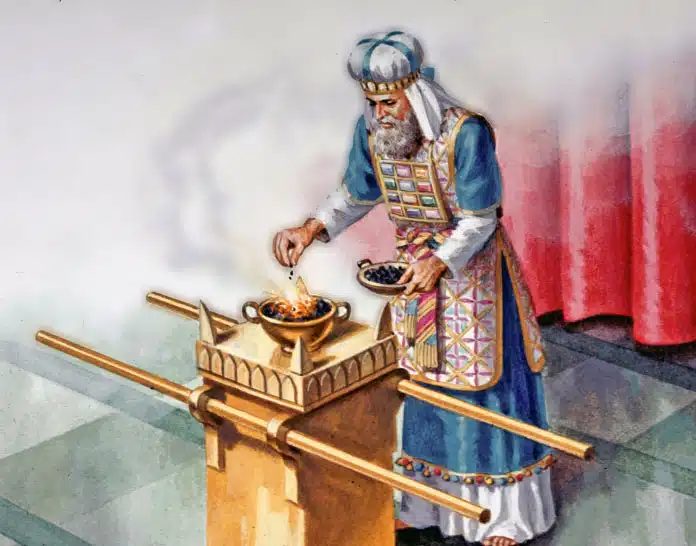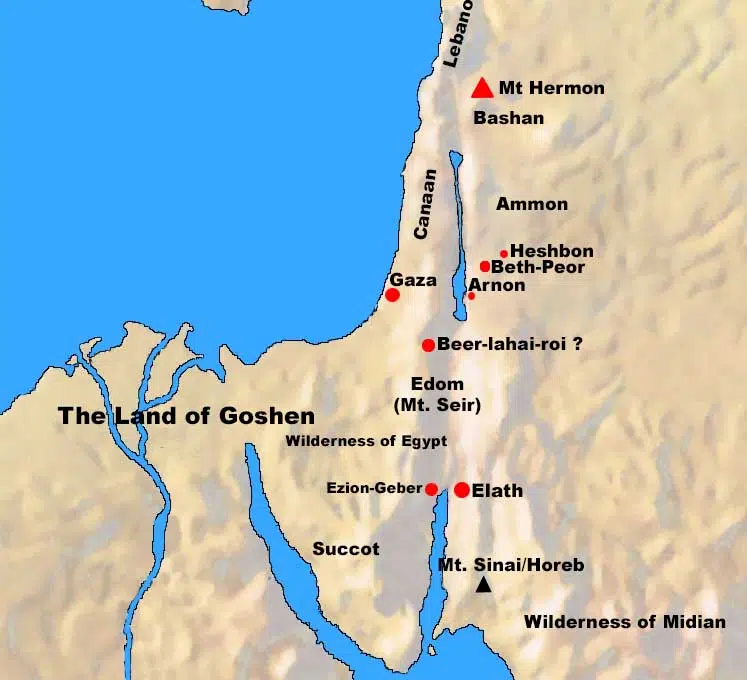The ephod is made. It is a special item of clothing for the high priest. It was fashioned of the material described in verse 1, along with twisted linen, as well as gold threads and onyx stones that would decorate it. The design of the ephod was given in Exodus 28:6 – 14.
Verse 2 lists the overall composition of the ephod. The word ephod is a transliteration of the same word in Hebrew, meaning there was no equivalent in English. It was probably similar to an apron and was draped over the shoulders and worn around the waist to cover the loins. Some think it was made in two pieces, a front piece and a back piece.

The ephod was made of gold, and of blue and purple and scarlet material, and fine twisted linen. To place the gold into the garment, the craftsmen hammered out gold sheets and cut them into threads. Therefore, the ephod was made of a weave consisting of dyed wool, twisted linen (flax), and threads of gold. Perhaps gold, the most precious metal, was included here because the ephod would be worn in the LORD’s presence. In the Bible, scarlet (red) often symbolizes sin, and white (like the linen) represents being cleansed from sin, as in their passage from Isaiah:
“Come now, and let us reason together,”
Says the LORD,
“Though your sins are as scarlet,
They will be as white as snow;”
(Isaiah 1:18).
Gold often symbolizes refined purity, as in Revelation 3:18 and 1 Corinthians 3:11-14. So these colors might represent the redeeming work of God, to cleanse His people of sin and purify them with His refining fire.
These threads would then be woven in with the blue and the purple and the scarlet material, and the fine linen. To ensure the finest quality, the ephod was the work of a skillful workman. Purple and blue were royal colors, as shown in Esther 8:15. Perhaps these colors symbolized, along with the gold, the majesty and power of Israel’s Suzerain King, with whom they had entered a covenant.
After the material was crafted, they made attaching shoulder pieces for the ephod; it was attached at its two upper ends. These shoulder pieces made it possible for the cloth of the ephod to be hung from the shoulders.
The next piece of the high priest’s clothing was the skillfully woven band. This band which was on the ephod was like its workmanship of the same material. The band (or “belt”) held the material close to the body as it hung from the shoulders. It was made of the same material: of gold and of blue and purple and scarlet material, and fine twisted linen, the material with which the ephod was made. All of this was done just as the Lord had commanded Moses.
Verses 6 – 7 relate the making of the onyx stones. The meaning of the Hebrew word for onyx (“shoham”) has been difficult to determine. Most translate it as onyx, a black stone used widely in the Ancient Near East. The Greek Old Testament (the Septuagint) translates it “emeralds,” a green stone. The Jewish Publication Society version of the Hebrew Bible renders it “lazuli stones.” A lazuli is a dark blue metamorphic stone.
These stones were set in gold filigree setting. Filigree is an intricate design fashioned from a metal, in this case, gold. So the onyx stones were housed in a setting of intricate gold decoration. Both gold and onyx stones are mentioned in Genesis 2:12 as being in the Garden of Eden. This would indicate they had both been considered precious for a considerable time.
Also, the onyx stones were engraved like the engravings of a signet, according to the names of the sons of Israel. Exodus 28:9 specified that six tribe names were to be engraved on each stone and were to be arranged “according to their birth.”
Then, the artisan placed the stones on the shoulder pieces of the ephod as memorial stones [or “stones of remembrance”] for the sons of Israel, just as the Lord had commanded Moses. The stones symbolized the twelve tribes being carried into the LORD’s presence on the shoulders of the high priest.
The ephod was worn by the high priest when he entered into the LORD’s presence in the Holy of Holies. With the names of the twelve tribes on the stones, he would carry their names before the LORD in order to intercede for them.
The ephod was thus a symbol of mediation and intercession. Today, Christ our LORD, who is our High Priest and mediator is the One Who intercedes for us, His covenant people (1 Timothy 2:5; Heb. 6:20, 8:1 – 3, 8:6, 9:11).
Biblical Text
2 He made the ephod of gold, and of blue and purple and scarlet material, and fine twisted linen. 3 Then they hammered out gold sheets and cut them into threads to be woven in with the blue and the purple and the scarlet material, and the fine linen, the work of a skillful workman. 4 They made attaching shoulder pieces for the ephod; it was attached at its two upper ends. 5 The skillfully woven band which was on it was like its workmanship, of the same material: of gold and of blue and purple and scarlet material, and fine twisted linen, just as the Lord had commanded Moses. 6 They made the onyx stones, set in gold filigree settings; they were engraved like the engravings of a signet, according to the names of the sons of Israel. 7 And he placed them on the shoulder pieces of the ephod, as memorial stones for the sons of Israel, just as the Lord had commanded Moses.
Check out our other commentaries:
-
Deuteronomy 4:25-31 meaning
When the Israelites live comfortably in Canaan, they and their children will fall into idolatry. Consequently, they will be removed from the land and will...... -
Isaiah 53:6 meaning
Isaiah prophesies that all of us like sheep have gone astray in our sin, but instead of punishing us, the LORD caused the sin of...... -
Genesis 2:18-25 meaning
Adam names all the living creatures, but a suitable helper was not found for him. God made woman from Adam’s rib and she became his...... -
Genesis 11:16-21 meaning
The genealogy covering the ten generations from Shem to Abraham continues with Peleg, Reu, and Serug. ...... -
Exodus 24:4-11 meaning
Moses and the elders are called to come before the LORD for worship. The covenant of the LORD is ratified.......



